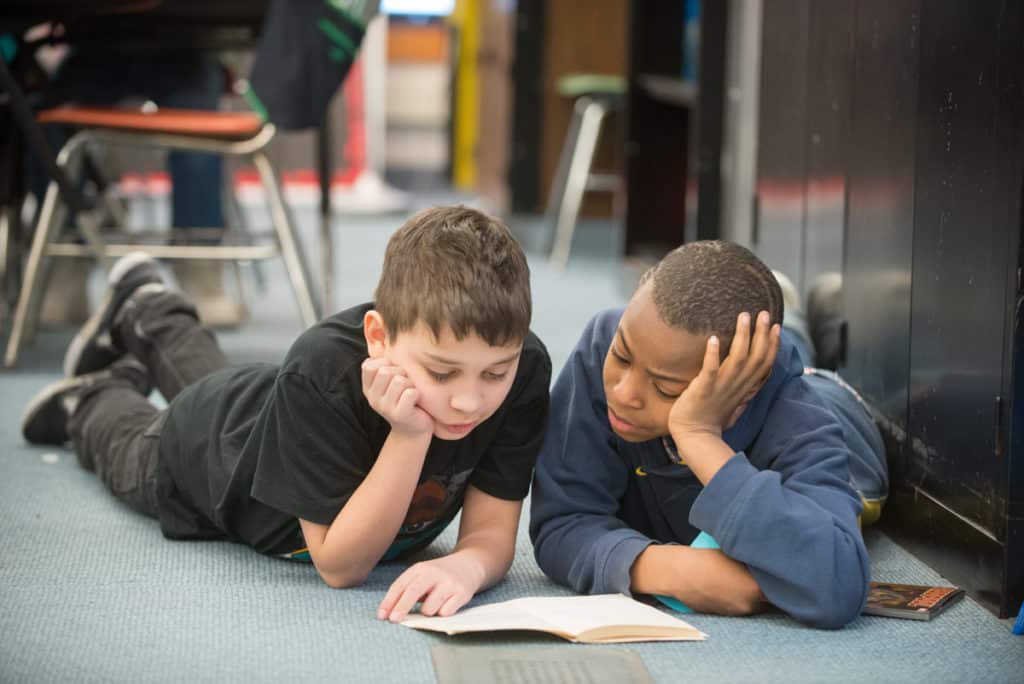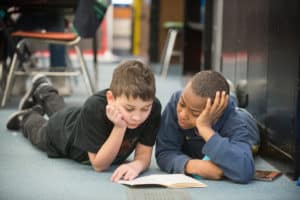
 When test scores indicated that students at the Lawrence Barnes School needed more work on vocabulary and reading comprehension, staff at the K–5 school devised a way to build skills and community at the same time. In the fall of 2005, Mary Weith and others from Barnes’s special education services team launched a schoolwide Word of the Week program, which gave every child many chances to hear, read, and use a particularly juicy vocabulary word over the course of a week. Then, after the Word of the Week routine had been established, they added a reading comprehension component: In the spring, each month’s words were drawn from a particular book, which was read aloud by each class during that month. This literacy initiative brought a sense of togetherness to the student body by giving them a shared repertoire of words and stories. Moreover, integrating the literacy work with a schoolwide focus on learning to live together as a caring, inclusive community made the project meaningful for students and teachers.
When test scores indicated that students at the Lawrence Barnes School needed more work on vocabulary and reading comprehension, staff at the K–5 school devised a way to build skills and community at the same time. In the fall of 2005, Mary Weith and others from Barnes’s special education services team launched a schoolwide Word of the Week program, which gave every child many chances to hear, read, and use a particularly juicy vocabulary word over the course of a week. Then, after the Word of the Week routine had been established, they added a reading comprehension component: In the spring, each month’s words were drawn from a particular book, which was read aloud by each class during that month. This literacy initiative brought a sense of togetherness to the student body by giving them a shared repertoire of words and stories. Moreover, integrating the literacy work with a schoolwide focus on learning to live together as a caring, inclusive community made the project meaningful for students and teachers.
All of the classroom teachers and most specialists at Barnes have completed at least one level of Responsive Classroom training. So it made sense to Mary and her teammates to have the first five words in the program be those referred to in the Responsive Classroom approach with the acronym CARES: cooperation, assertion, responsibility, empathy, and self-control—key social skills children need to learn and practice if they are to succeed socially and academically. Since the CARES words were already part of the “common language” of the school’s adult community, focusing on them not only enriched students’ vocabulary, it gave them a base for understanding their teachers’ expectations as they began the school year. Opportunities for using the CARES words and living by those values came up naturally in the process of making classroom rules, learning to put these rules into action in the classroom, and practicing respectful behavior in the lunchroom and other common areas.
Throughout the year, each week’s word was posted, with a simple definition, on two bulletin boards: one near the main entrance to the school, and another at smaller children’s eye level in the K–1 hallway. Classroom teachers displayed the word and its definition in their rooms, and principal Paula Bowen used it in context in each day’s morning announcements. Paula helped children make connections through situational examples. Some examples were serious (relating empathy to victims of Hurricane Katrina). Others were playful (asking, “If your dog said hello to you when you came home from school today, would you be astonished?”).
Throughout the week, teachers integrated work with the word into classroom curriculum, using it in Morning Meeting messages and other discussions and activities. When students found examples used in context, they added them to a community display. To wrap things up, each month’s All-School Assembly included a fun activity based on the past few weeks’ vocabulary words.
The reading comprehension component was added after Word of the Week had been underway for several months. At a January in-service day, four teaching teams each selected one book for which they would choose words and coordinate activities. Their selections were appropriate for reading aloud to students in grades K–5 and addressed themes that resonated with the school’s diverse student body: Weslandia (Paul Fleischman), The Sneetches (Dr. Seuss), Uncle Rain Cloud (Tony Johnston), and My Name is Jorge: On Both Sides of the River (Jane Medina). Reading First funding provided each class with copies of the books to read together. Because words of the week were related to the month’s book, every week brought an opportunity to review the story and explore its connection to a new word.
At the end of each month, the team that had selected the book coordinated an all-school assembly. These celebrations included performances that related to the book’s themes and reinforced the month’s words. For instance, when the school read The Sneetches, K–1 teachers and students adapted and performed a play that offered a similar message and used that month’s vocabulary words.
By the end of the year, Barnes students had learned many new words, read four books together, and demonstrated their new knowledge in ways that knit the community together. Principal Paula Bowen is delighted with how the program evolved in its first year: “Word of the Week and its accompanying assemblies have been a really fun way to expose our students to the power of words and have helped to improve comprehension skills. Having the whole school read the same book each month created a great sense of community among both students and staff. It was fun and took very little time, but had great impact. What more could you ask for?”